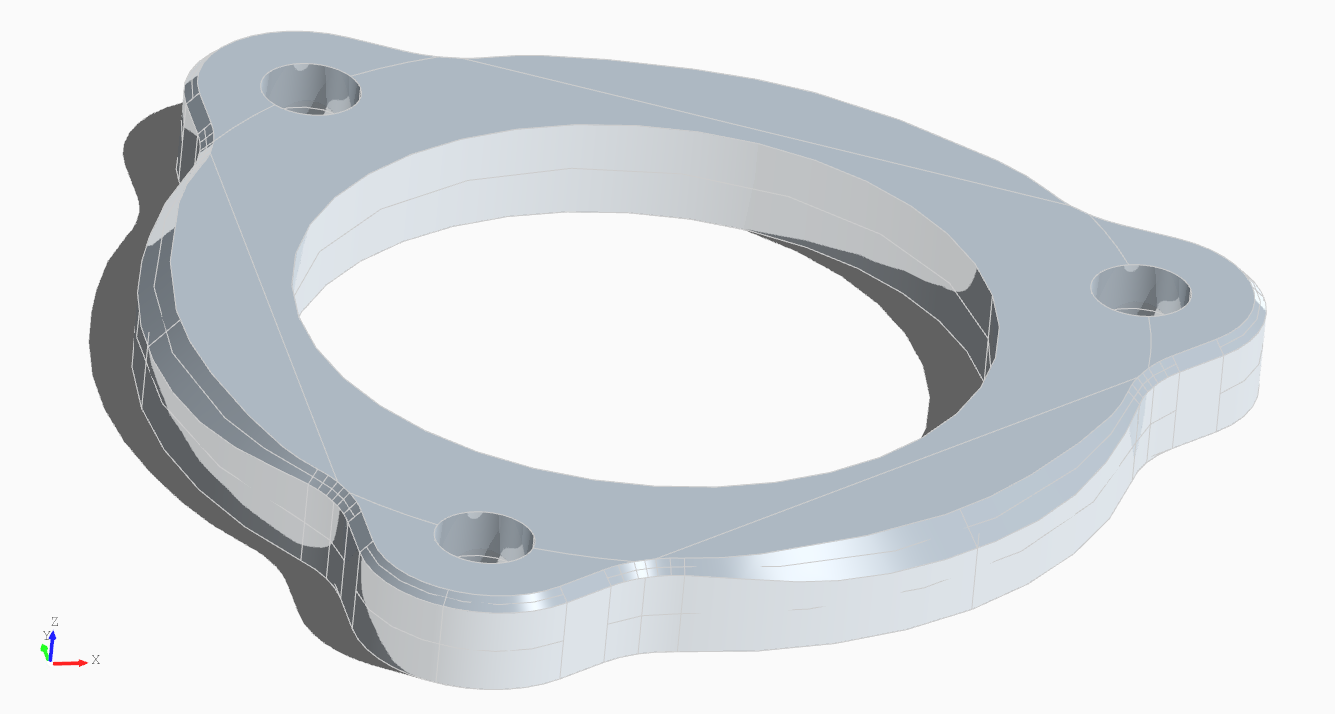Chamfer
The Chamfer declaration can be used to add a straight cut to edges on a shape. There's several different types of chamfer operations that can be performed so let's cover each.

The screenshot above demonstrates the following chamfer operations:
- Chamfering all edges of a shape with a the same
distanceand optionaldistance2(shown in orange) - Chamfering only faces given in the operations list with the same
distanceand optionaldistance2attribute (shown in red) - Chamfering specific sets of faces with specific dstances by defining them in the
operationslist (shown in purple) - Chamfering specific sets of edges and faces pairs by defining them in the
operationslist (shown in blue) - Chamfering any combination of the above by setting them in the in the
operationslist (shown in green)
The code for the chamfer example is as follows:
""" This example shows how to use chamfer operations
See https://dev.opencascade.org/doc/overview/html/occt_user_guides__modeling_algos.html#occt_modalg_6
for more on how this works.
"""
from declaracad.occ.api import Part, Box, Chamfer
enamldef Assembly(Part):
name = "Chamfer Operations"
Chamfer:
# If no operations are given it applies to all faces
distance = 20
Box:
position = (-300, 0, 0)
dx = 200
dy = 200
dz = 200
Chamfer:
# Or you can supply which faces to apply the chamfer to
# and you can change the slope by specifying distance2
color = 'red'
distance = 20
distance2 = 40
attr top_face = self.children[0].topology.faces[5]
attr bottom_face = self.children[0].topology.faces[4]
operations = [top_face, bottom_face]
Box:
position = (300, 0, 0)
dx = 200
dy = 200
dz = 200
Chamfer:
# You also supply specify different chamfer distances for each chamfer
color = 'purple'
operations = [
(20, self.children[0].topology.faces[5]),
(50, self.children[0].topology.faces[4]),
]
Box:
dx = 200
dy = 200
dz = 200
Chamfer:
# You can supply a tuple of (edge, face) to define which edges of a
# given face should be chamfered
color = 'blue'
distance = 20
attr top_face = self.children[0].topology.faces[5]
attr top_edges = self.children[0].topology.edges_from_face(top_face)
operations = [
(top_edges[0], top_face),
(top_edges[2], top_face)
]
Box:
position = (0, -300, 0)
dx = 200
dy = 200
dz = 200
Chamfer:
# You also supply the chamfer distances for these as well
color = 'green'
attr top_face = self.children[0].topology.faces[5]
attr bottom_face = self.children[0].topology.faces[4]
attr top_edges = self.children[0].topology.edges_from_face(top_face)
operations = [
(70, 20, top_edges[0], top_face),
(50, top_edges[2], top_face),
(50, bottom_face)
]
Box:
position = (0, 300, 0)
dx = 200
dy = 200
dz = 200
Distance and angle
The operations list can now accept a ChamferData object (available from declaracad.occ.api import ChamferData) which supports the specifying a distance and angle in radians along with the face and reference edge.
Chamfer:
# Using ChamferData
color = 'teal'
operations = [
ChamferData(
angle=radians(30),
distance=50,
edge=cyl.topology.edges[0],
face=cyl.topology.faces[1],
)
]
Cylinder: cyl:
position = (400, 400, 0)
radius = 100
height = 200

Variable width chamfer
DeclaraCAD can now also perform a chamfer with variable widths. To use it provide a list of parametric values and widths in the operations list along with the edge.

enamldef CylinderEdge(Part):
attr h = 4
Chamfer:
material = 'aluminium'
color = 'slategray'
attr edges = plate.topology.edges
attr profile_edges = (58, 130, 163)
attr top_edges = (46, 50, 54, 58, 71, 130, 137, 141, 145, 154, 158, 162, 163, 170, 174, 178, 182, 186)
attr profile = [
(0, 0.5),
(0.2, 1),
(0.5, 1.2),
(0.8, 1),
(1, 0.5),
]
operations = [
(profile if i in profile_edges else 0.5, edges[i])
for i in top_edges
]
Cut: plate:
Fillet:
radius = 5
attr edges = self.children[0].topology.edges
operations = [
edges[i] for i in ( 24, 26, 28, 33, 38, 42, 46, 50, 54)
]
Fuse:
Cylinder:
radius = 20
height = h
Extrude:
vector = (0, 0, h)
Face:
Polygon:
radius = 30
co unt = 3
Cylinder: # Center hole
radius = 14
height = h
Looper: # Bolt holes
iterable = [0, 120, -120]
Cylinder:
attr r = 20
attr a = radians(loop.item)
position = (r*cos(a), r*sin(a))
radius = 2
height = h
Note: At the moment it requires a patch to OCCT.
